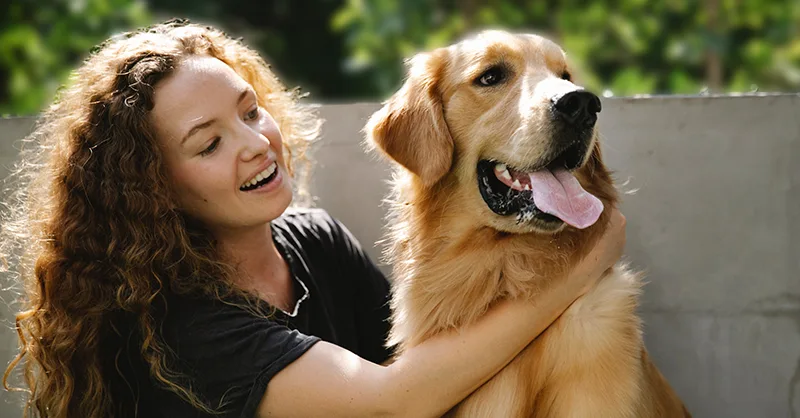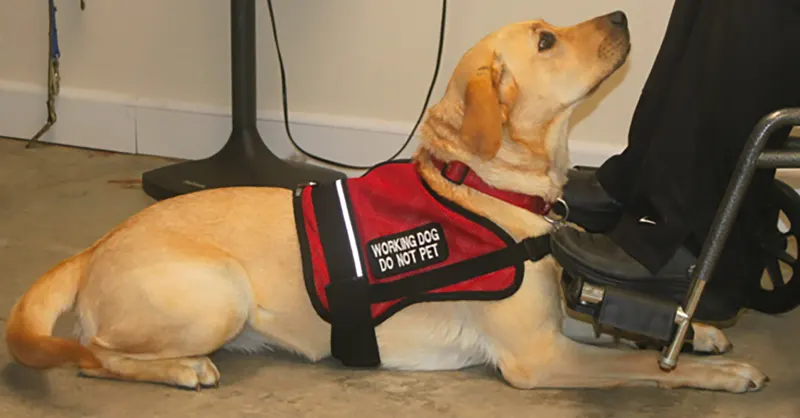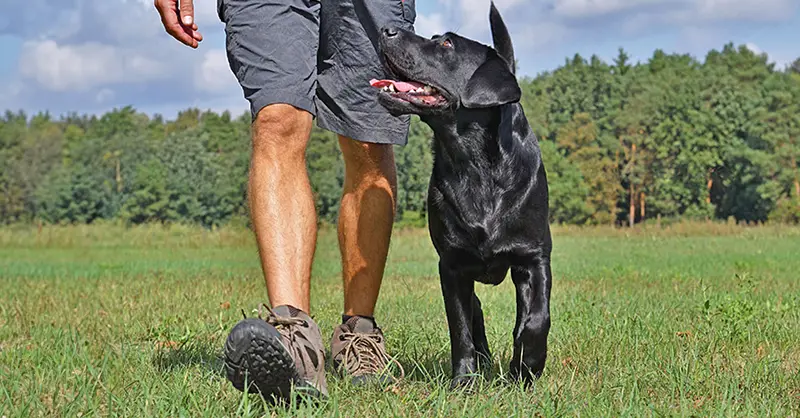Archive for the ‘Service Dog Tips’ Category
Understanding when your service dog is stressed is crucial for both their well-being and their effectiveness in assisting you. Let’s delve into the signs of stress in service dogs, with illustrative examples, and explore what steps you can take to alleviate their stress.
Recognizing Stress in Service Dogs Physical Signs of Stress Change in Body Language: A stressed dog might have a lowered head, a tucked tail, or flattened ears. For example, if your dog, who normally stands alert, starts showing a hunched back, it could be a sign of discomfort. Health Symptoms: Keep an eye out for physical symptoms like diarrhea or vomiting. A dog that usually has a hearty appetite but suddenly refuses meals might be stressed. Behavioral Indicators Altered Behaviors: If your usually calm dog starts barking excessively or shows aggression, these could be stress indicators. For instance, a service dog that starts growling in situations it previously handled well might be signaling distress. Excessive Grooming: A dog licking its paws more than usual can be a sign of anxiety. Service-Specific Signs Decreased Responsiveness: If your service dog starts ignoring commands or is slow in performing tasks, it’s a red flag. For example, a guide dog that suddenly stops leading effectively might be stressed. Reluctance to Work: Showing avoidance towards its harness or reluctance to perform its duties is a key sign. A dog that hesitates or pulls away from its harness, which it normally wears without issue, is exhibiting stress. Impact of Stress on Service DogsStress not only affects a service dog’s health but can also significantly impact its ability to perform necessary tasks. For example, a stress-affected service dog might become distracted easily, leading to potential safety risks for its handler.
Addressing Stress in Service Dogs Regular Veterinary Care: Regular check-ups can rule out health issues. For instance, a dog that becomes lethargic may have an underlying medical condition rather than just stress. Monitoring and Documentation: Track your dog’s behavior patterns. A diary noting instances when your dog seems anxious, like during loud events, can help identify stress triggers. Creating a Supportive Environment: Ensuring a calm environment is crucial. If possible, avoid exposing your dog to overly stressful situations, like crowded, noisy places. Ongoing Training and Socialization: Keep reinforcing positive training and socialization. For example, if your dog is nervous around children, gradual, positive exposure can help reduce stress. Seeking Professional Advice: If signs of stress persist, consulting a veterinarian or a professional dog trainer is essential. Handler’s Stress Management: Your emotional state can affect your dog. Practicing stress-relief techniques can have a positive impact on your dog’s well-being. Ensuring Proper Rest and Nutrition: Adequate rest and a balanced diet are fundamental for managing stress. For instance, a well-rested dog is less likely to be irritable in stressful situations. ConclusionIdentifying and addressing stress in your service dog is key to maintaining their health and ensuring they can perform their duties effectively. Regular observation, healthcare, and a supportive environment are essential.
If you’re concerned about your service dog’s stress levels, don’t hesitate to seek professional help. Remember, a happy and healthy service dog is a more effective and reliable companion.
Determining if a service dog is ready for duty requires a clear understanding of the Americans with Disabilities Act (ADA) guidelines, recognizing essential skills and behaviors, and evaluating the dog’s preparedness through various assessments.
This guide delves into the ADA requirements, key abilities a service dog should possess, and the significance of Public Access Tests (PATs) in gauging readiness.
ADA Requirements for Service Dog ReadinessUnder ADA guidelines, a service dog is a dog trained to assist a person with a disability. Key requirements include:
Disability-Specific Training: The dog must be trained to perform tasks specifically related to the handler’s disability. A service dog is not deemed ready until it reliably performs these tasks across different environments. Behavior Control: The dog must consistently be under the handler’s control through a harness, leash, or verbal commands. Essential Abilities for Service DogsIn addition to performing disability-related tasks, a service dog should exhibit the following abilities before being considered ready for duty:
Basic Obedience: Proficiency in commands such as sit, stay, come, down, and heel. Effective Socialization: Demonstrating comfort and calmness in various settings, around diverse people and other animals. Non-Aggressive Behavior: The dog should consistently show no signs of aggression. Distraction Resistance: The ability to maintain focus on the handler despite external distractions. Public Etiquette: Displaying appropriate behavior in public spaces, refraining from seeking attention or interacting with others without a command.It’s important to note that while service dogs must be accommodated in public spaces, they can be asked to leave if they cause a disturbance or exhibit inappropriate behavior.
Evaluating Readiness Through Public Access TestA Public Access Test (PAT) is essential for evaluating a service dog’s readiness. It assesses the dog’s behavior in public to ensure safe and appropriate accompaniment of the handler in diverse settings.
The Public Access Test includes navigating crowds, responding to noises, and behaving appropriately in public spaces like restaurants. While passing a PAT is not a requirement under the ADA, some organizations may offer certificates upon successful completion.
A Public Access Test helps to evaluate if your dog is ready for duty as a service dog. Certifying Service Dog ReadinessIt’s vital to understand that no ADA-mandated certification exists for service dog readiness. Accessories like certificates, ID cards, and vests, while potentially helpful, are not legally required. The responsibility of determining a service dog’s readiness lies with the handler, who must ensure their dog is fully trained to assist with their specific disability.
For handlers who self-train their service dogs, consulting a professional trainer is advisable if there’s any uncertainty about meeting the required standards.
ConclusionDetermining a service dog’s readiness for duty involves ensuring compliance with ADA requirements, assessing the dog’s training and behavior, and often conducting a Public Access Test.
This process requires understanding the specific training a dog receives to assist with a disability and recognizing the subtleties in the dog’s behavior and performance.
Service dogs act as essential aides for many people facing physical or psychological disabilities. Recognizing their vital assistance, Pennsylvania has set forth laws that protect the rights of service dog handlers.
In the Keystone State, service dogs are granted full access to public areas where other animals might typically be restricted. Additionally, these dogs are permitted in residential buildings where pets aren’t usually allowed (without having to pay pet charges).
This guide will discuss the rights of service dogs in Pennsylvania, the qualifications necessary for their handlers, and whether a registration process is required.
Who’s eligible to handle a service dog in Pennsylvania?Service dogs are more than pets; they’re legally designated assistance animals tasked with aiding individuals with disabilities. The Americans with Disabilities Act (ADA) categorizes a person with a disability as someone:
“who has a physical or mental impairment that substantially limits one or more major life activities.”
Eligibility in Pennsylvania requires that the handler must have a verifiable physical or mental health disability. The service dog, trained either by the handler or a professional, must be capable of performing tasks specific to the handler’s needs.
These dogs can perform a myriad of tasks, such as guiding individuals who are visually impaired, providing comfort and assistance for those with psychiatric issues, or assisting with physical mobility, among others. Those that cater specifically to mental health are often referred to as psychiatric service dogs.
Navigating Service Dog Registration in PennsylvaniaIs registration compulsory? There is actually no legal requirement in Pennsylvania to formally register service dogs. While you don’t need to provide registration documentation to validate your service dog’s status, many handlers choose to register voluntarily to obtain an ID card.
Handlers frequently use indicators such as vests, ID cards, and certificates to signal their dog’s special status. These symbols help differentiate a standard pet from a trained service dog, potentially reducing confrontations in places where pets aren’t typically permitted and ensuring the dog’s role is respected.
It’s vital to remember that these items are not official proof of a service dog’s legitimacy. Their presentation should not be a condition of access. They’re primarily for the handler’s convenience.
In Pennsylvania, when a service dog’s role isn’t immediately evident, individuals may ask only two specific questions:
Is the dog a service animal required because of a disability? What work or task has the dog been trained to perform?After answering these two questions satisfactorily, a service dog handler in Pennsylvania should be granted access to public spaces without any further documentation.
For handlers interested in registering their service dog and obtaining an ID card, platforms like Service Dog Certifications (SDC) are commonly used. The process for registering a service dog with SDC in Pennsylvania includes:
Confirm your status as a service dog handler. Provide details about the service dog and handler. Submit an email address for communication and receipt of a digital ID. Upload a current photograph of your service dog. Select additional items, such as extra ID cards, collar tags, or vests, if desired. Essential Training for Service Dogs in PennsylvaniaA dog must undergo rigorous training specific to the handler’s needs to be considered a service dog. Additionally, they should demonstrate excellent behavior and control in public settings.
Common training methods include:
Acquire a dog that has already been trained. Hire a professional to provide specialized training. Self-train your dog, which can deepen the bond between handler and animal. This should only be undertaken if you’re thoroughly familiar with the necessary training techniques. Service Dog Laws and Regulations in PennsylvaniaAlongside the federal ADA regulations, Pennsylvania enforces its own laws to reinforce the rights of service dog handlers. In Pennsylvania, consistent with ADA guidelines, individuals with disabilities are permitted to bring their service animals into all public facilities.
There are several laws in Pennsylvania that protect service dog owners. For example, the Pennsylvania Human Relations Act (PHRA) governs state and local government activities and many privately owned public accommodations within Pennsylvania. In addition, there are many local laws in cities like Philadelphia and Pittsburgh that further protect disability rights when it comes to service dog access.
It’s also crucial to understand that under the Pennsylvania Criminal Code, it is a summary offense for proprietors, managers, or employees of public accommodations to deny access to disabled individuals with service dogs.
There can be severe legal consequences for violating the rights of a service dog handler. In one case, a $100,000 settlement was reached when a 16-year-old special needs student was denied accommodation for her service dog. The psychiatric service dog was trained to detect rising cortisol levels on her breath, which indicate stress and anxiety, and alert those around her of an oncoming panic attack or seizure.
ConclusionThis guide aims to help Pennsylvania residents navigate the world of service dogs, ensuring that both handlers and their dogs receive the respect and rights they’re due. Understanding and adhering to these guidelines will help foster a supportive environment for service dogs and their handlers across the state.







